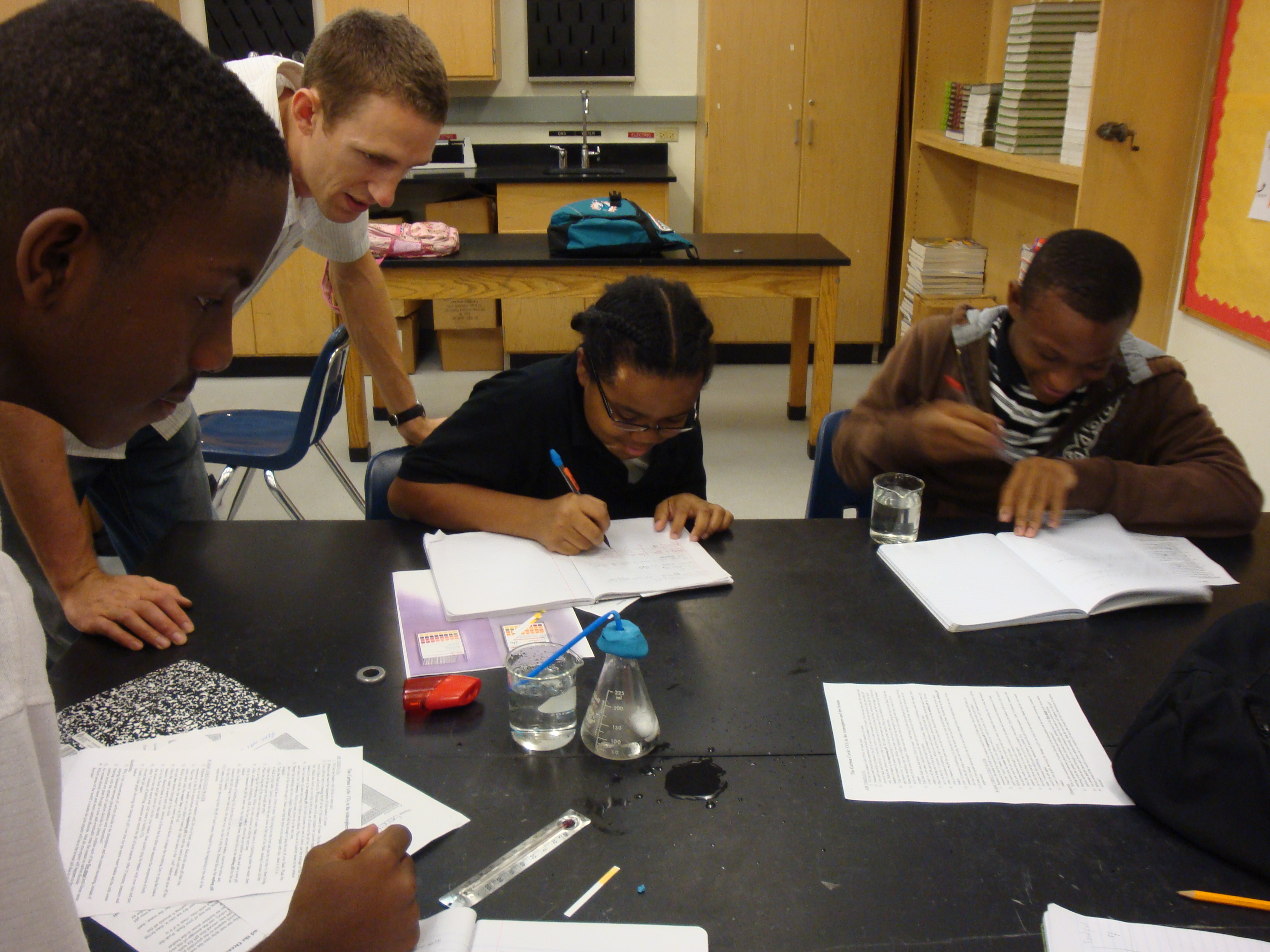A record five graduate students at universities in Florida have been awarded $5,000 scholarships as winners of the Guy Harvey Scholarship, recognizing their outstanding achievement in marine science research.
The winners are Felipe Carvalho and Sarah Stephens, University of Florida; M. Laura Habegger, University of South Florida; Sean Bignami, University of Miami; and Kier Smith, Florida Atlantic University.
The scholarship, established in 2010 through a partnership between Florida Sea Grant and the Guy Harvey Ocean Foundation, recognizes students at Florida universities whose research focuses on novel strategies for improving sustainable management of large marine fish and sharks.

Sean Bignami conducting an ocean acidification lab activity at Carol City Middle School as part of the Science Made Sensible program.
“Originally, the Guy Harvey Foundation had planned on providing two scholarships,” says Florida Sea Grant director Karl Havens. “However, when they saw the high quality of applicants, the foundation was tremendously generous in deciding to support the research of five students.
“Clearly the innovative work proposed by these students will have major impacts in regard to meeting the objective of the award.”
Since the award was established three years ago, $24,000 in scholarships has been given to six students at Florida universities. Recipients also receive a certificate designed and signed by well-known marine wildlife artist and conservationist Guy Harvey.
Carvalho is conducting research related to the management of blue shark populations in the Atlantic Ocean. His research is about supporting the training of scientists and technicians to use remote sensing methods to track movement of these large predators.
Stephens is working with fishing guides in three Caribbean regions to teach them how to use dart tags to track the movements of permit, working in cooperation with the Bonefish Tarpon Trust.
Habegger is studying how the principles of physics and engineering can be used to understand the role of the bill when billfishes feed, in hopes of discovering practical management strategies, such as specialized fishing gear that reduces by-catch in commercial fisheries, or reduces stress on billfish caught in recreational tournaments.
Bignami is studying how the changing chemistry of marine waters as a result of ocean acidification might affect the early development of large marine fish, using mahi mahi and cobia as case studies.
Smith is developing and testing a method for treating fishing hooks with a graphite and zinc mixture which in preliminary tests appears to be effective in keeping sharks from biting the hooks. The ultimate goal is to reduce the number of sharks caught in long-line commercial fisheries.
The Guy Harvey Ocean Foundation is an organization of philanthropists, conservationists, scientists and educators that emphasizes sensible strategies for promoting ocean conservation and the development of the next generation of marine scientists. The foundation funds research and educational programs developed by universities, colleges, institutes and nonprofit organizations.
Learn more about winners of the Guy Harvey Scholarship at this link. More details about each of the current winners follow below.

Felipe Carvalho
Felipe Carvalho, a native of Recife, Brazil, is known as a prolific publisher of peer-reviewed scientific journals, and an award-winning presenter at national and international fisheries meetings. He has earned his master’s degree in the Program of Fisheries and Aquatic Sciences at UF, and is now a doctoral student there continuing his research in blue shark stock assessments.
He has already served six times as a national representative to the International Commission for the Conservation of Atlantic Tunas, the international organization that focuses on the research and management of Atlantic tunas and other species such as sharks caught during tuna fishing.
Carvalho plans to use his award to defray his travel costs when delivering statistical analysis training to fisheries staff in South Africa. The goal of the training is to improve the country’s ability to assess the impact of its commercial fishery on shark populations.
“International cooperation is a valuable way to augment technical capacity in countries where fisheries science and ecosystem management is insufficiently developed,” Carvalho wrote in his scholarship application. “This workshop will not only assist in the conservation of pelagic sharks in the Atlantic Ocean through research and capacity building, but will also improve my teaching and mentoring skills.”

Sarah Stephens
Sarah Stephens holds her undergraduate degree in zoology from North Carolina State University, and is now pursuing a master’s in the Program of Fisheries and Aquatic Sciences at UF.
As part of her current research, she organizes Florida’s conservation tagging program for permit, one of the state’s most economically valuable recreational fisheries. The program relies on recreational anglers to report data on tag and capture locations when they land a previously marked permit, which in turn generates information that researchers use to assess fish populations and movement patterns. The research is a joint venture among UF, the Florida Fish and Wildlife Conservation Commission and the Bonefish Tarpon and Trust.
Stephens plans to use her award to augment the Florida work by expanding the tagging program into Belize and Mexico, where permit are among the high profile species that sustain a lucrative fly fishing industry catering to international visitors.
“I want my work to be relevant to management and conservation,” Stephens wrote in her scholarship application. “I know the research I complete with funding from the Guy Harvey scholarship will be an integral part of my growth as a fisheries scientist.”

Laura Habegger
Laura Habegger is a native of Argentina and holds her bachelor’s degree from the University of Buenos Aires. She completed her master’s degree from the University of South Florida studying the bite force mechanics of top predators such as bull sharks and great barracuda. Her doctoral work at USF is the first ever to study the bill mechanics and feeding adaptations in marlin, swordfish, sailfish and other pelagic predators.
The bill is the most prominent feature of billfish, but there are competing explanations for its function. Habegger’s interdisciplinary approach to finding the answer incorporates elements of engineering, anatomy and physiology mixed with materials testing, high-speed photography and digital x-ray imaging.
“All conservation efforts start with an understanding of the basic biology of a species,” Habegger writes in her scholarship application. “By the combination of anatomy, biomechanics and the use of innovative techniques, this project will contribute to the description of the feeding behavior and ecology in billfishes.”
Habegger’s early experiences studying fish biology at the Museum of Natural Sciences in Buenos Aires fueled her ongoing interest in fisheries conservation, and she plans to use her Guy Harvey scholarship to cover the costs of her research and educational expenses related to her doctoral work.

Sean Bignami
Sean Bignami is pursuing a Ph.D. at the University of Miami Rosenstiel School of Marine and Atmospheric Science. He holds a bachelor’s degree in aquatic biology from the University of California at Santa Barbara.
Bignami plans to use his Guy Harvey scholarship to further research that attempts to quantify for the first time the effects of ocean acidification on the development, growth and behavior of two popular catches of marine fish, cobia and mahi-mahi.
He also plans to dedicate much of his career to sharing the results of his research with decision-makers to ensure marine resources are managed effectively. He has also been actively involved in teaching marine science to teachers and students, and for the last two years has worked with the “Science Made Sensible” outreach program. The effort pairs Miami graduate students in science, math and engineering disciplines with middle school science teachers to provide students with more hands-on learning experiences.
“Communication is often not the strongest point of a scientist’s skill set, at least not when considering the general public’s need for information to be delivered in a simple way that highlights application to their everyday lives,” Bignami wrote in his scholarship application. “Reaching the public at a young age may be the most important way to instill love and appreciation for the ocean and the services it provides.”

Kier Smith
Kier Smith is a native of Minnesota who has found a second home at sea. He earned a bachelor’s degree in biology from Florida Atlantic University, holds advanced scuba and rescue diver certifications, and has logged more than 15,000 nautical miles on ocean-going vessels.
He plans to use his award to fund his master’s work at FAU, which seeks to reduce the incidental catch of sharks and rays in long line commercial fisheries. Previous research has shown that fishing hooks treated with rare-earth metals react in saltwater and produce a stimulus that a shark’s peculiar electrosensory system can detect and avoid. The high cost of the metals, however, makes use of the hooks unfeasible.
Smith and his research professor have received a preliminary patent on a technique they think mimics the deterrent properties of rare-earth metals in a more cost-effective way. In essence, the hook is treated with a mix of zinc and graphite, which, when immersed in saltwater, becomes essentially a battery, producing an electric stimulus that repulses sharks.
“I believe we have discovered a far more cost-effective way to create the same deterrent effect that has the potential for large-scale use in commercial long line fishing,” Smith wrote in his scholarship application. “This study has the potential to reduce the impact of this industry on shark populations and the marine ecosystem worldwide.”



